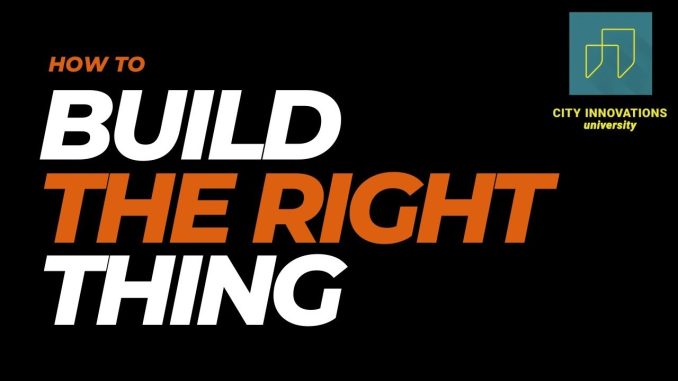
In the world of product development, few questions are as critical—and as elusive—as “Are we building the right thing?” It’s a deceptively simple inquiry that can determine the success or failure of a venture. Yet, many teams charge ahead with development, driven by deadlines, assumptions, and enthusiasm, without ever truly validating whether their solution aligns with real user needs or market demand. Knowing whether you’re building the right thing isn’t just about intuition or experience; it’s about cultivating a mindset of continuous discovery, feedback, and alignment.
At the heart of this challenge lies the difference between building something right and building the right thing. The former is a matter of execution—clean code, scalable architecture, intuitive design. The latter is a matter of purpose. You can build a flawless product that no one wants, or a clunky prototype that solves a real problem and gains traction. The distinction is crucial. Building the right thing means solving a problem that matters to someone, in a way that they’re willing to adopt, pay for, or advocate. It’s not just about functionality; it’s about relevance.
One of the most common pitfalls in product development is falling in love with the solution rather than the problem. Teams often start with an idea—sometimes born from personal frustration, sometimes from a flash of inspiration—and immediately begin shaping it into a product. They sketch wireframes, write user stories, and build MVPs, all without deeply interrogating whether the problem they’re solving is real, urgent, and widespread. The danger here is that assumptions go unchallenged. You might believe users need a better way to manage their tasks, but unless you’ve spoken to them, observed their behavior, and understood their context, you’re operating in a vacuum.
Customer discovery is the antidote to this. It’s not a one-time phase, but an ongoing practice of engaging with users, listening to their pain points, and validating your hypotheses. This doesn’t mean sending out surveys and hoping for statistically significant results. It means having conversations—open-ended, curious, and empathetic. When you ask users about their workflows, frustrations, and goals, you begin to see patterns. You learn what they’ve tried before, what they’re currently doing, and what they wish existed. These insights are gold. They help you refine your problem statement and ensure that your solution is grounded in reality.
But even with strong user insights, it’s easy to veer off course. That’s why it’s essential to define success early and revisit it often. Success isn’t just launching the product or hitting a revenue target. It’s about creating meaningful impact. What does success look like for your users? Is it saving time, reducing errors, increasing confidence? When you define these outcomes clearly, you can measure progress and course-correct when needed. Metrics like engagement, retention, and customer satisfaction become more than vanity numbers—they become signals of whether you’re on the right track.
Another powerful way to know if you’re building the right thing is to prototype and test early. There’s a tendency to wait until a product is polished before showing it to users, but that’s a mistake. Early prototypes—whether they’re sketches, clickable mockups, or simple landing pages—allow you to gather feedback before you’ve invested too much. They invite users into the process and help you understand what resonates and what doesn’t. Sometimes, a feature you thought was essential turns out to be irrelevant. Other times, users highlight needs you hadn’t considered. These moments of clarity are invaluable.
Market signals also play a role. If you’re solving a problem that’s already being addressed by multiple competitors, that’s not necessarily a bad thing—but it does mean you need to differentiate. What’s your unique angle? Are you targeting a niche that others have overlooked? Are you offering a better experience, a more affordable solution, or a novel approach? On the flip side, if no one is addressing the problem, ask why. Is it because the problem isn’t painful enough, or because it’s too complex to solve profitably? Understanding the competitive landscape helps you position your product and avoid building something that’s either redundant or irrelevant.
Internal alignment is another key factor. Teams often have different interpretations of what they’re building and why. Product managers may focus on user needs, engineers on technical feasibility, and executives on business goals. If these perspectives aren’t aligned, the product can become fragmented. Regular communication, shared goals, and a clear product vision help ensure that everyone is rowing in the same direction. When the team understands not just what they’re building, but why it matters, the work becomes more focused and impactful.
Ultimately, knowing if you’re building the right thing is less about certainty and more about adaptability. It’s about being willing to challenge your assumptions, listen deeply, and pivot when necessary. It’s about staying close to your users and being honest about what’s working and what’s not. The best teams don’t just build—they learn. They treat every feature, every release, and every conversation as an opportunity to refine their understanding and improve their product.
In a fast-moving world, the right thing today might not be the right thing tomorrow. That’s why the question must be asked continuously, not just at the start of a project. Are we still solving the right problem? Are our users still experiencing the same pain points? Has the market shifted? By staying curious and responsive, you increase your chances of building something that truly matters. And when you do, the impact is undeniable—not just for your users, but for your team, your business, and your own sense of purpose.